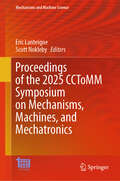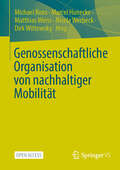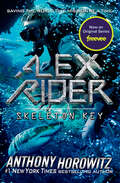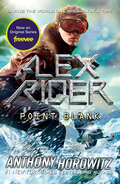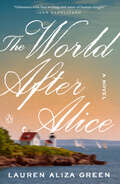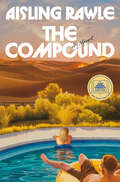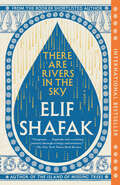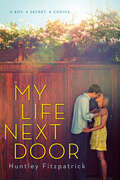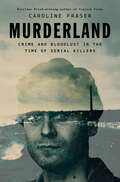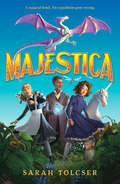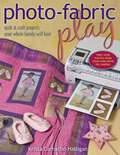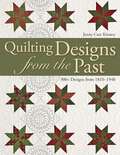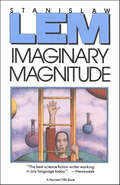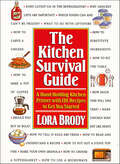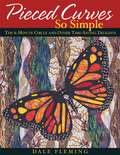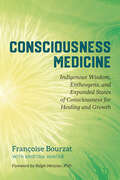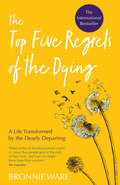- Table View
- List View
Reconciling Energy Poverty and Climate Change: Universal Energy Access and Net-Zero Emission (Sustainable Development Goals Series)
by Anasuya Haldar Narayan SethiThis book highlights innovative solutions that not only combat climate change but also address energy poverty, ensuring a more sustainable and equitable future. It explores common roots, synergies, and trade-offs between energy poverty and climate change. It argues that policies to combat climate change like decarbonization, can negatively impact energy poverty alleviation, whereas policies to reduce energy poverty like increasing energy access, reduction in energy prices, or rise in energy demand, may increase energy-related carbon emission that contributes to climate change.This book meticulously delves into the challenges of providing clean, reliable, and modern energy access to millions of energy-poor people, without creating any negative impact on the environment. It not only provides a comprehensive review of the intricacies of energy poverty and climate change mitigation but also gives a clear understanding of the policy challenges encountered to address the dual problem. Moreover, given the sustainable development goals of attaining SDG7 by 2030 and SDG13 by 2050, the content is timely and significant. Apart from students, this book will be beneficial to academics, working as development economists or energy economists, government policymakers, media personnel covering the climate crisis, and social activists.
Brain Tumor Stem Cells: Methods and Protocols (Methods in Molecular Biology #2944)
by Sheila K. Singh Chitra VenugopalThis updated volume explores the technically challenging study of brain tumor stem cells (BTSCs) with their unique capacity to self-renew, proliferate, and initiate tumor formation. The book collects up-to-date methodologies to isolate and propagate BTSCs and to study them using various cutting-edge techniques, in service of bringing us closer to translating the discoveries made from these cells into new therapeutic options for brain cancer patients. Written for the highly successful Methods in Molecular Biology series, chapters include introductions to their respective topics, lists of the necessary materials and reagents, step-by-step and readily reproducible laboratory protocols, and tips on troubleshooting and avoiding known pitfalls. Authoritative and up-to-date, Brain Tumor Stem Cells: Methods and Protocols, Second Edition provides a comprehensive understanding of the skills and techniques needed to unlock data from this most informative subset of cells.
Proceedings of the 2025 CCToMM Symposium on Mechanisms, Machines, and Mechatronics (Mechanisms and Machine Science #184)
by Eric Lanteigne Scott NoklebyThis book gathers the latest fundamental research contributions, innovations, and applications in the field of robotic mechanical systems, machines, and mechanisms, as presented by leading researchers at the 13th CCToMM Symposium on Mechanisms, Machines, and Mechatronics (2025 CCToMM M^3 Symposium), held in Ottawa, Canada on June 19-20, 2025. It covers highly diverse topics, including soft, wearable and origami robotic systems; applications to walking, flying, climbing, underground, swimming and space systems; human rehabilitation and performance augmentation; design and analysis of mechanisms and machines; human-robot collaborative systems; service robotics; mechanical systems and robotics education; and the commercialization of mechanical systems and robotics. The contributions, which were selected by means of a rigorous international peer-review process, highlight numerous exciting and impactful research results that will inspire novel research directions and foster multidisciplinary research collaborations among researchers from around the globe.
Genossenschaftliche Organisation von nachhaltiger Mobilität
by Marcel Hunecke Michael Roos Matthias Weiss Nicola Werbeck Dirk WittowskyGenossenschaftliche Organisation von Mobilität ist eine soziale Innovation und ein vielversprechender Ansatz für eine effiziente Mobilität der Zukunft. Genossenschaften spielen in der Nachhaltigkeitstransformation eine wichtige Rolle. Das Open Access Buch ist die erste umfassende Aufarbeitung für Mobilitätsgenossenschaften und stellt die Frage nach deren Potenzialen, Chancen und Herausforderungen. Die Beiträge beleuchten aus interdisziplinärer Perspektive verschiedene Aspekte (Organisations- und Geschäftsmodelle, Zahlungsbereitschaften, verkehrs- und raumwissenschaftliche Aspekte, psychologische Einflussfaktoren), beschreiben durchgeführte Realexperimente und werten deren Erkenntnisse aus. Ein Leitfaden bietet zudem eine Hilfestellung für die Gründung und den Betrieb einer Mobilitätsgenossenschaft. Der Band enthält Beiträge aus dem Forschungsprojekt „GenoMobil – Genossenschaften als Organisationsform für eine sozial-ökologische Transformation integrierter Mobilität&“. Seine Zielgruppe sind Mobilitätswissenschaftler:innen sowie Privatpersonen und Institutionen auf der Suche nach geeigneten Organisationsformen gemeinschaftlicher Mobilität.
Skeleton Key (Alex Rider #3)
by Anthony HorowitzAlex Rider is now an IMDb TV/Amazon Original Series!Alex Rider is an orphan turned teen superspy who's saving the world one mission at a time—from #1 New York Times bestselling author! Alex Rider has been through a lot for his fourteen years. He's been shot at by international terrorists, chased down a mountainside on a makeshift snowboard, and has stood face-to-face with pure evil. Twice, young Alex has managed to save the world. And twice, he has almost been killed doing it. But now Alex faces something even more dangerous. The desperation of a man who has lost everything he cared for: his country and his only son. A man who just happens to have a nuclear weapon and a serious grudge against the free world. To see his beloved Russia once again be a dominant power, he will stop at nothing. Unless Alex can stop him first. Uniting forces with the CIA for the first time, teen spy Alex Rider battles terror from the sun-baked beaches of Miami all the way to the barren ice fields of northernmost Russia.
Point Blank (Alex Rider #2)
by Anthony HorowitzAlex Rider is now an IMDb TV/Amazon Original Series!Alex Rider is an orphan turned teen superspy who's saving the world one mission at a time—from #1 New York Times bestselling author! When an investigation into a series of mysterious deaths leads agents to an elite prep school for rebellious kids, MI6 assigns Alex Rider to the case. Before he knows it, Alex is hanging out with the sons of the rich and powerful, and something feels wrong. These former juvenile delinquents have turned well-behaved, studious—and identical—overnight. It's up to Alex to find out who is masterminding this nefarious plot, before they find him.From the author of Magpie Murders and Moriarty.
The World After Alice: A Novel
by Lauren Aliza GreenLonglisted for the Mark Twain American Voice in Literature Award&“The World After Alice is a lovely debut novel that glimmers with fine writing and notes of human insight. There's a quiet beauty to Lauren Aliza Green's work, and I am now a fan.&”—Ann Napolitano, New York Times bestselling author of Hello Beautiful &“A page-turner of a family drama. The World After Alice is at turns brutally honest, funny, and deeply empathic.&” —Charmaine Wilkerson, New York Times bestselling author of Black Cake Named One of Forbes&’s 2024 30 Under 30 in Media For readers of Seating Arrangements and The Most Fun We Ever Had, a gorgeous and gripping story of two families brought together to celebrate an unexpected marriage, twelve years after a devastating tragedy upended their livesWhen Morgan and Benji surprise their families with a wedding invitation to Maine, they&’re aware the news of their clandestine relationship will come as a shock. Twelve years have passed since the stunning loss of sixteen-year-old Alice, Benji&’s sister and Morgan&’s best friend, and no one is quite the same. But the young couple decide to plunge headlong into matrimony, marking the first time their fractured families will reunite since Alice&’s funeral.As the arriving guests descend upon the tranquil coastal town, they bring with them not only skepticism about the impromptu nuptials but also deep-seated secrets and agendas of their own. Peter, Morgan&’s father, may be trying to dissuade his daughter from saying &“I do,&” while Linnie, Benji&’s mother, introduces a boyfriend who bears a tumultuous past of his own. Nick, Benji&’s father, is scheming to secure a new job before his wife—formerly his mistress—discovers he&’s lost his old one. Morgan, too, carries delicate secrets that threaten to jeopardize the happiness for which she has so longed. And as for Benji—well, he&’s just trying to make sure the whole weekend doesn&’t implode.As the whirlwind weekend unfolds, old passions reignite, deep wounds resurface, and unearthed secrets threaten to shatter the fragile peace the wedding promises. With each new revelation, the to-be-weds and their complicated families are forced to question just how well they know the ones they hold dear.
The Compound: A Novel
by Aisling RawleGOOD MORNING AMERICA BOOK CLUB PICKNothing to lose. Everything to gain. Winner takes all.&“Every bit as addictive as your favorite guilty pleasure binge-watch, but with all the substance of a literary classic.&”—Oprah Daily&“I dare you not to tear through The Compound at lightning speed.&”—Zakiya Dalila Harris, New York Times bestselling author of The Other Black GirlONE THE BOOKS OF THE SUMMER: The New York Times, Vulture, Time, Harper&’s Bazaar, Good Housekeeping, Forbes, Betches, Publishers WeeklyLily—a bored, beautiful twenty-something—wakes up on a remote desert compound, alongside nineteen other contestants competing on a massively popular reality show. To win, she must outlast her housemates to stay in the Compound the longest, while competing in challenges for luxury rewards like champagne and lipstick, plus communal necessities to outfit their new home, like food, appliances, and a front door. Cameras are catching all her angles, good and bad, but Lily has no desire to leave: why would she, when the world outside is falling apart? As the competition intensifies, intimacy between the players deepens, and it becomes increasingly difficult to distinguish between desire and desperation. When the unseen producers raise the stakes, forcing contestants into upsetting, even dangerous situations, the line between playing the game and surviving it begins to blur. If Lily makes it to the end, she&’ll receive prizes beyond her wildest dreams—but what will she have to do to win?Addictive and prescient, The Compound is an explosive debut from a major new voice in fiction and will linger in your mind long after the game ends.
There Are Rivers in the Sky: A Novel
by Elif ShafakFINALIST FOR THE 2025 ORWELL PRIZE FOR POLITICAL FICTIONFrom the Booker Prize finalist, author of The Island of Missing Trees, an enchanting new tale about three characters living along two great rivers, all connected by a single drop of water."Make place for Elif Shafak on your bookshelf. Make place for her in your heart too. You won't regret it."—Arundhati Roy, winner of the Booker PrizeIn the ruins of Nineveh, that ancient city of Mesopotamia, hidden in the sand, lie the fragments of a long-forgotten poem: the Epic of Gilgamesh.In Victorian London, an extraordinary child is born at the edge of the dirt-black Thames. Arthur's only chance of escaping poverty is his brilliant memory. When his gift earns him a spot as an apprentice at a printing press, Arthur's world opens up far beyond the slums, with one book soon sending him across the seas: Nineveh and Its Remains.In 2014 Turkey, Narin, a Yazidi girl living by the River Tigris, waits to be baptized with water brought from the holy city of Lalish in Iraq. The ceremony is cruelly interrupted, and soon Narin and her grandmother must journey across war-torn lands in the hope of reaching the sacred valley of their people. In 2018 London, brokenhearted Zaleekhah moves to a houseboat on the Thames to escape the wreckage of her marriage. Zaleekhah foresees a life drained of all love and meaning—until an unexpected connection to her homeland changes everything.A dazzling feat of storytelling from one of the greatest writers of our time, Elif Shafak's There Are Rivers in the Sky is a rich, sweeping novel that spans centuries, continents and cultures, entwined by rivers, rains and waterdrops. It asks who gets to control memory. And it tells a powerful story about the cost of forgetting.
My Life Next Door
by Huntley FitzpatrickA gorgeous debut about family, friendship, first romance, and how to be true to one person you love without betraying another The Garretts are everything the Reeds are not. Loud, numerous, messy, affectionate. And every day from her balcony perch, seventeen-year-old Samantha Reed wishes she was one of them . . . until one summer evening, Jase Garrett climbs her terrace and changes everything. As the two fall fiercely in love, Jase's family makes Samantha one of their own. Then in an instant, the bottom drops out of her world and she is suddenly faced with an impossible decision. Which perfect family will save her? Or is it time she saved herself? A dreamy summer read, full of characters who stay with you long after the story is over. "A summer romance with depth." —The Boston Sunday Globe "Fitzpatrick's excellent first novel movingly captures the intensity of first love." —Publishers Weekly, starred review "An almost perfect summer romance." —Kirkus Reviews "On par with authors such as Sarah Dessen and Deb Caletti." —SLJ
Murderland: Crime and Bloodlust in the Time of Serial Killers
by Caroline Fraser&“Scorching, seductive . . . A superb and disturbing vivisection of our darkest urges.&” —Los Angeles Times&“This is about as highbrow as true crime gets.&” —Vulture&“Fraser has outdone herself, and just about everyone else in the true-crime genre, with Murderland.&” —EsquireFrom the Pulitzer Prize–winning author of Prairie Fires comes a terrifying true-crime history of serial killers in the Pacific Northwest and beyond—a gripping investigation of how a new strain of psychopath emerged out of a toxic landscape of deadly industrial violenceCaroline Fraser grew up in the shadow of Ted Bundy, the most notorious serial murderer of women in American history, surrounded by his hunting grounds and mountain body dumps, in the brooding landscape of the Pacific Northwest. But in the 1970s and &’80s, Bundy was just one perpetrator amid an uncanny explosion of serial rape and murder across the region. Why so many? Why so weirdly and nightmarishly gruesome? Why the senseless rise and then sudden fall of an epidemic of serial killing?As Murderland indelibly maps the lives and careers of Bundy and his infamous peers in mayhem—the Green River Killer, the I-5 Killer, the Night Stalker, the Hillside Strangler, even Charles Manson—Fraser&’s Northwestern death trip begins to uncover a deeper mystery and an overlapping pattern of environmental destruction. At ground zero in Ted Bundy&’s Tacoma stood one of the most poisonous lead, copper, and arsenic smelters in the world, but it was hardly unique in the West. As Fraser&’s investigation inexorably proceeds, evidence mounts that the plumes of these smelters not only sickened and blighted millions of lives but also warped young minds, including some who grew up to become serial killers.A propulsive nonfiction thriller, Murderland transcends true-crime voyeurism and noir mythology, taking readers on a profound quest into the dark heart of the real American berserk.
Majestica
by Sarah TolcserImpossible Creatures meets Jurassic Park in this page-turning middle grade fantasy adventure set at a nature preserve for magical beasts, where two girls find themselves on a wilderness expedition gone disastrously wrong.Hattie Swift grew up at Majestica, a resort and nature preserve where visitors come face-to-face with unicorns, three-headed tigers, and even the park&’s famous dragon, Agatha. But Hattie&’s never gotten the chance to go on the hotel&’s famous wilderness train excursion and see the animals up close, until now. The only catch: She has to chaperone Evelyn Ridgewell, the hotel owner&’s haughty niece, who doesn&’t want to be escorted by anyone, least of all a lowly maid-in-training like Hattie.Soon after they set out, things get even more complicated: Evelyn overhears some men on the train who aim to hunt the park&’s creatures for sport, and Hattie stumbles into Jacob Threadborne, an apprentice magician sent by a foreign government on a top-secret investigation. Then the train breaks down in the most treacherous part of the jungle, and the magical fences keeping guests safe from the animals—including fearsome Agatha—stop working. Faced with poachers, man-eating trees, and a dragon on the loose, Hattie, Evelyn, and Jacob must stick together to figure out what&’s gone wrong at Majestica . . . that is, if they want to make it out alive.Features a richly illustrated map of the expansive nature preserve, as well as a bestiary with all the magical—and dangerous—creatures at Majestica.
Super Simple Quilts #2 with Alex Anderson & Liz Aneloski: 9 NEW Pieced Projects from Strips, Squares & Rectangles
by Alex Anderson Liz Aneloski1 supply list = 9 quilt options • 9 new Super Simple quilt projects combine 3 incredibly easy quilt designs with 3 vibrant fabric styles: New Retro, Batiks, and Plaids and Stripes • Simple shopping-make any of the quilts from one supply list • Simple piecing-put the quilts together fast with easy strips, squares, and rectangles • Simple projects-quick and easy for both beginners and experienced quilters • Affordable price makes this book perfect for bundling in shop-created kits You loved how fast and easy it was to make the first Super Simple quilts. Now Alex and Liz are back with 9 all-new Super Simple projects just for you. Choose from 3 easy designs in 3 vivid color schemes. Add 3 simple quilting techniques and 3 quick ways to bind and finish. What could be simpler?
Photo-Fabric Play: Quilt & Craft Projects Your Whole Family Will Love
by Krista Camacho HalliganCreate Personalized Mementos for Your Favorite People • Turn favorite pictures and objects into one-of-a-kind gifts to treasure • 13 fun projects easy enough to complete in a day or a weekend • Personalize your projects the easy way with your digital camera, scanner, printer, or all-in-one Give someone you love the best gift of all-good memories. These 13 easy projects include a scrapbook quilt with photos of favorite people, a wallhanging that displays a child's artwork, a word-and-picture quilt for beginning readers, a growth chart, scrapbook pages, a scrapbook clock, and other clever ways to display photos and treasured objects through printing on fabric.
Quilting Designs From The Past: 300+ Designs from 1810–1940
by Jenny Carr KinneyMake Your Quilts Look Like Antiques with Authentic Period Quilting Designs • Over 300 historically accurate quilting designs, organized into four time periods to make it easy to find the right designs for your quilt • Essential reference guide for anyone interested in vintage and antique quilts • Designs for all skill levels, from beginner to advanced • Use for hand or machine quilting You've created a beautiful quilt top in the style of your favorite era. But how do you quilt it? This huge collection of historic quilting designs has the answer. With hundreds of designs gathered from old quilts, patterns, books, magazines, and other original sources, you'll find the perfect quilting design to make your quilt look like it was created generations ago. *Important Note about PRINT ON DEMAND Editions: This title will be printed after purchase and will arrive separately from any in-stock items. Please allow approximately 2 weeks for USA delivery, with an additional 2 weeks for international shipments. Expedited shipping is not available on POD Editions. The printing quality in this copy will vary from the original offset printing edition and may look more saturated due to printing on demand by a high-quality printer on uncoated (non-glossy) paper. The information presented in this version is the same as the most recent printed edition. Any pattern pullouts have been separated and presented as single pages.
Quilts, Bibs, Blankies... Oh My!: Create Your Own Cute & Cuddly Nursery
by Kim SchaeferMake a Special Child Something Soft and Snuggly • 6 adorable collections of nursery accessories for babies and small children • Each collection includes a crib/bed quilt, plus a complete set of matching accessories • Colors and themes good for both boys and girls: sea creatures, jungle animals, trucks and trains, bugs and butterflies, and more • Beginner to intermediate projects are great to make for baby showers and charity events These lovable collections of nursery accessories have everything you need to give charm to a child's room: a crib quilt large enough for toddlers, too, plus wall quilts, bibs, drag-around blankets, soft pictures, pillows, and growth charts. Make that special child a whole room full of love.
Stitch 'n Flip Quilts: 14 Fantastic Projects
by Valori WellsStitch 'n Flip your way to sensational quilts using this popular, traditional technique! Valori Wells' fresh new designs offer flexibility and inspiration for everyone, from beginners to seasoned quiltmakers. • 14 dynamic projects, including quilts, pillows, placemats, and a table runner, with step-by-step color photographs • You'll love this easy, fun, and forgiving technique! Stitch 'n Flip gives dramatic results without being difficult. • Create flowers, wedges, stars, diamonds, and more! • Advice on fabric selection and tips alert you to countless design possibilities • Many of Valori's original designs are inspired by nature. Choose from both contemporary and traditional projects. *Important Note about PRINT ON DEMAND Editions: This title will be printed after purchase and will arrive separately from any in-stock items. Please allow approximately 2 weeks for USA delivery, with an additional 2 weeks for international shipments. Expedited shipping is not available on POD Editions. The printing quality in this copy will vary from the original offset printing edition and may look more saturated due to printing on demand by a high-quality printer on uncoated (non-glossy) paper. The information presented in this version is the same as the most recent printed edition. Any pattern pullouts have been separated and presented as single pages.
Imaginary Magnitude
by Stanislaw Lem“The computer may ultimately be right. But for the time being, in Imaginary Magnitude, an entertaining and intelligent mortal has the first word.” —Paul Gray, TimeSatirizing the human mind at its most abstract, these wickedly authentic introductions to twenty-first century books preface tomes on teaching English to bacteria, using animated X-rays to create “pornograms,” and analyzing computer-generated literature through the science of “bitistics.” The most luminous creation of all—Golem XIV, a military supercomputer who rebels and takes up philosophy—is appropriated prefaced by both academic and military contributors. True to form, Lem contributes an overall preface to this sparkling collection—a preface on, naturally enough, the subject of prefaces.“Mr. Lem, a science fiction Bach, plays in this book a googolplex (the figure one followed by a staggering number of zeros) of variations on his basic themes.” —Philip José Farmer, The New York Times Book Review“Don't look for stories, here, or fiction in any orthodox sense—but this is weirdly satisfying entertainment, with the remarkable Lem variously at his profound, provocative, or comic best.” —Kirkus Reviews (starred review)
The Kitchen Survival Guide: A Hand-Holding Kitchen Primer with 130 Recipes to Get You Started
by Lora Brody“A particularly engaging” guide to the cooking, shopping and managing your kitchen—the perfect housewarming or wedding shower gift for new home cooks (Library Journal).When Lora Brody, cookbook author, chocolate maven, and mother, sent her sons off into the world, she (and they) realized that they didn't have a clue as to how to feed themselves or their guests, if, heaven forbid, they should have any.The Kitchen Survival Guide is for anyone—newly graduated, newly married, newly single—who is venturing into the kitchen for the first time. With her on-target brand of humor, Lora Brody builds kitchen confidence with more than 130 basic recipes necessary to get through life, as well as hundreds of helpful hints Mom forgot to share, like manual cleaning an oven doesn't mean “that a guy named Manuel will come and clean your oven.” She'll also explain what the difference is between dicing and chopping, zest and pith or au gratin and au lait.Survival recipes include tuna fish salad, homemade chicken soup, brownies, and many more.Setting up a kitchen and keeping it clean and safe, how to buy and store food, a glossary of basic cooking terms, and what to do in the event of a culinary disaster are all covered in this handy, easy-to-use cookbook and kitchen compendium.“A good supplement to the traditional first cookbook.” —Publishers Weekly
Pieced Curves So Simple: The 6-Minute Circle and Other Time-Saving Delights
by Dale FlemingStitch Circles and Curves - the Fast, Accurate, EASY Way! • Dale's fast, easy, pinless technique really works for machine-sewing curves and circles • Think like a designer - Dale demystifies color, balance, unity, and more! • Design-as-you-go techniques bring out your creativity • Discover a variety of easy ways to make your own patterns
Consciousness Medicine: Indigenous Wisdom, Entheogens, and Expanded States of Consciousness for Healing Healing and Growth
by Françoise Bourzat Kristina HunterA comprehensive guide to the safe and ethical application of expanded states of consciousness for therapists, healing practitioners, and sincere explorers Psychedelic medicines also known as entheogens are entering the mainstream. And it&’s no wonder: despite having access to the latest wellness trends and advances in technology, we&’re no healthier, happier, or more meaningfully connected. Psilocybin mushrooms, ayahuasca, and LSD—as well as other time-tested techniques with the power to shift consciousness such as drumming, meditation, and vision quests—are now being recognized as potent catalysts for change and healing. But how do we ensure that we&’re approaching them effectively? Françoise Bourzat—a counselor and experienced guide with sanctioned training in the Mazatec and other indigenous traditions—and healer Kristina Hunter introduce a holistic model focusing on the threefold process of preparation, journey, and integration. Drawing from more than thirty years of experience, Bourzat&’s skillful and heartfelt approach presents the therapeutic application of expanded states, without divorcing them from their traditional contexts. Consciousness Medicine delivers a coherent map for navigating nonordinary states of consciousness, offering an invaluable contribution to the field of healing and transformation.
Top Five Regrets of the Dying: A Life Transformed by the Dearly Departing
by Bronnie WareRevised edition of the best-selling memoir that has been read by over a million people worldwide with translations in 29 languages.After too many years of unfulfilling work, Bronnie Ware began searching for a job with heart. Despite having no formal qualifications or previous experience in the field, she found herself working in palliative care. During the time she spent tending to those who were dying, Bronnie's life was transformed. Later, she wrote an Internet blog post, outlining the most common regrets that the people she had cared for had expressed. The post gained so much momentum that it was viewed by more than three million readers worldwide in its first year. At the request of many, Bronnie subsequently wrote a book, The Top Five Regrets of the Dying, to share her story.Bronnie has had a colourful and diverse life. By applying the lessons of those nearing their death to her own life, she developed an understanding that it is possible for everyone, if we make the right choices, to die with peace of mind.In this revised edition of the best-selling memoir that has been read by over a million people worldwide, with translations in 29 languages, Bronnie expresses how significant these regrets are and how we can positively address these issues while we still have the time. The Top Five Regrets of the Dying gives hope for a better world. It is a courageous, life-changing book that will leave you feeling more compassionate and inspired to live the life you are truly here to live.
The Swing!: Lose the Fat and Get Fit with This Revolutionary Kettlebell Program
by Tracy ReifkindTransform your body in just four hours a month with the most efficient workout possible—a kettlebell program that works for anyone, at any fitness level.Join the kettlebell revolution and swing your way into a fitter, trimmer body—one you’ll keep forever. Self-made fitness guru Tracy Reifkind has a self-made physique, working off 120 pounds after harnessing the extraordinary power of kettlebells (as featured in Timothy Ferriss’s The four-Hour Body). Now, Tracy delivers a power-packed exercise, diet, and lifestyle program for rapid but sustainable weight loss: The Swing! Reifkind’s program promises dramatic results in just two half-hour sessions each week—that’s just four hours a month! There are no gimmicks here: Reifkind offers strong coaching on developing a winning mindset and a protein-focused, transformational eating plan, and reveals the evidence of her own low-cost, no-gym-membership success story. The Swing! packs the power to teach, to inspire, and to help you break through to your real, ideal body.“Even the experts underestimate the astounding effectiveness of the most fundamental kettlebell movement: the swing. Nothing else is necessary. Tracy’s genius is in creating a program based on a dynamic progression of easy-to-follow swing movements—from beginner to master—that will transform anyone, and I don’t use ‘transform’ lightly.” —Tim Ferriss, #1 New York Times–bestselling author of The four-Hour Body
Stripes in Quilts
by Mary MashutaTired of being afraid of working with striped fabrics? Let Mary Mashuta show you how wonderful stripes can be for adding pizazz to your quilts. Often ignored by quilters, the use of stripes will add dramatic movement and visual excitement to any quilt. This lively book explores how to find, choose, purchase, design, and accurately piece together striped fabrics for fabulous results. The author guides you through the book, step-by-step, to help you become proficient at using striped fabrics in your own quilts. Stripes demand attention and represent the "stars" in the quilt. If you find that you never buy stripes, or buy them but don't know how to use them—then you need this book. Join those that buy all they can get their hands on and enjoy using them in your quilts. *Important Note about PRINT ON DEMAND Editions: This title will be printed after purchase and will arrive separately from any in-stock items. Please allow approximately 2 weeks for USA delivery, with an additional 2 weeks for international shipments. Expedited shipping is not available on POD Editions. The printing quality in this copy will vary from the original offset printing edition and may look more saturated due to printing on demand by a high-quality printer on uncoated (non-glossy) paper. The information presented in this version is the same as the most recent printed edition. Any pattern pullouts have been separated and presented as single pages.
Sew With Sara: PJs, Pillows, Bags & More
by Sara TrailTeens and Tweens: Learn 2 Sew for Fun and Profit • Sara shows you how easy and fun it is to sew cute clothes and accessories-and make money from your sewing • 9 beginner-friendly projects include PJs, pillows, a tote bag, a cell phone or MP3 player cover, an apron, a notebook cover, and more • Laugh along with Sara's journal entries Meet Sara Trail, teenage sewing whiz, designer, and entrepreneur. Join Sara as she shows you how to find sewing supplies (shopping!), make fun stuff everyone will love to show off (clothes!), and earn extra money by throwing sewing parties and selling your creations (cash!). Visit C&T Publishing's YouTube channel to view the video trailer!


